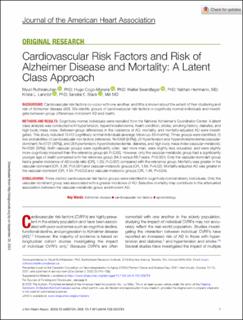Cardiovascular Risk Factors and Risk of Alzheimer Disease and Mortality: A Latent Class Approach
Ruthirakuhan, Myuri; Cogo-Moreira, Hugo; Swardfager, Walter; Herrmann, Nathan; Lanctot, Krista L.; Black, Sandra E.
Peer reviewed, Journal article
Published version
Date
2023Metadata
Show full item recordCollections
Original version
Journal of the American Heart Association. 2023, 12 (1), Artikkel e025724. 10.1161/JAHA.122.025724Abstract
BackgroundCardiovascular risk factors co‐occur with one another, and little is known about the extent of their clustering and risk of Alzheimer disease (AD). We identify groups of cardiovascular risk factors in cognitively normal individuals and investigate between‐group differences in incident AD and death.Methods and ResultsCognitively normal individuals were recruited from the National Alzheimer's Coordinator Center. A latent class analysis was conducted with hypertension, hypercholesterolemia, heart condition, stroke, smoking history, diabetes, and high body mass index. Between‐group differences in the incidence of AD, mortality, and mortality‐adjusted AD were investigated. This study included 12 412 cognitively normal individuals (average follow‐up, 65 months). Three groups were identified: (1) low probabilities of cardiovascular risk factors (reference; N=5398 [43%]), (2) hypertension and hypercholesterolemia (vascular‐dominant; N=5721 [46%]), and (3) hypertension, hypercholesterolemia, diabetes, and high body mass index (vascular‐metabolic; N=1293 [10%]). Both vascular groups were significantly older, had more men, were slightly less educated, and were slightly more cognitively impaired than the reference group (all P<0.05). However, only the vascular‐metabolic group had a significantly younger age of death compared with the reference group (84.3 versus 88.7 years, P<0.001). Only the vascular‐dominant group had a greater incidence of AD (odds ratio [OR], 1.30; P<0.001) compared with the reference group. Mortality was greater in the vascular‐dominant (OR, 3.26; P<0.001) and vascular‐metabolic groups (OR, 1.84; P=0.02). Mortality‐adjusted AD was greater in the vascular‐dominant (OR, 1.54; P=0.02) and vascular‐metabolic groups (OR, 1.46; P=0.04).ConclusionsThree distinct cardiovascular risk factor groups were identified in cognitively normal elderly individuals. Only the vascular‐dominant group was associated with a greater incidence of AD. Selective mortality may contribute to the attenuated association between the vascular‐metabolic group and incident AD.

